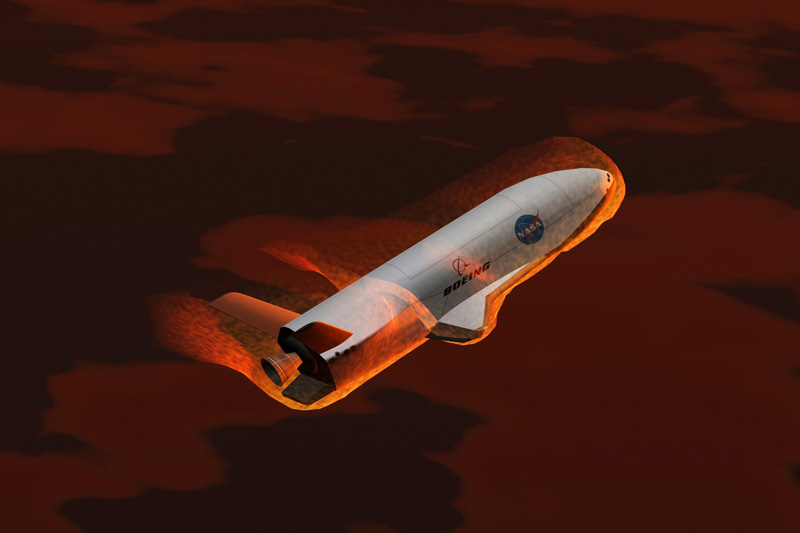Secretive X-37B Robot Space Plane Returns to Earth on Autopilot

After seven months in space, the U.S.Air Force's secretive X-37B unmanned space plane returned to Earth today towrap up a debut flight shrouded in secrecy.
The robotic X-37Bspace plane landed at Vandenberg Air Force Base in California to end its maiden voyage. The space plane, also known as Orbital Test Vehicle1, glided back to Earth over the Pacific Ocean before landing at the revampedVandenberg runway at about 1:16 a.m. PST (0916 GMT) today (Dec. 3).
"Today's landing culminates asuccessful mission based on close teamwork between the 30th Space Wing, Boeingand the Air Force Rapid Capabilities Office," said Lt Col Troy Giese,X-37B program manager from the AFRCO, which oversaw the mission. "We arevery pleased that the program completed all the on-orbit objectives for thefirst mission."
In all, the X-37B space planespent more than 220 days in orbit. Air Force officials said earlier this week that the X-37B could land anytime between Friday and Monday (Dec. 3 to Dec. 6).
The Air Force has kept theexact nature and cost of the X-37B'ssecretive mission a closely guarded secret, but some analysts andskywatchers have speculated that the spacecraft served as an unmanned orbitalspy platform.
Robot space drone's longflight
The Air Force launched the robotspace plane atop an equally unmanned Atlas 5 rocket on April 22. Since then,the spacecraft has orbited Earth, at times tracked by meticulous skywatchers who first spotted the spacecraft in space using telescopes, then noticed its apparent manuevers to change orbits. ?[Videoof the X-37B in space]
Breaking space news, the latest updates on rocket launches, skywatching events and more!
"This is a historicalfirst, not only for Vandenberg Air Force Base, but for the Air Force and ournation to receive a recoverable spacecraft here and really take a step forwardin advancing unmanned space flight," said 30th Space Wing commander Col.Richard Boltz in a statement before the landing.
The X-37B space drone isrobotic winged spacecraft that looks in many ways like a miniature spaceshuttle.? It was built by Boeing's Phantom Works Division in Seal Beach, Calif.,and can fly long, extended missions because of its solar array power system,which allows it to stay in orbit for up to 270 days, Air Force officials havesaid.
Originally, NASA used theX-37B space plane as an experimental test bed until funding for the project ranout in 2004. The vehicle then passed to the Defense Advanced Research ProjectsAgency and was ultimately turned over to the Air Force in 2006.
X-37B's mystery mission
Air Force officials havesaid the X-37B Orbital Test Vehicle 1 is being used todemonstrate and test guidance, navigation and control systems, as well as evaluateautonomous landing techniques for winged spacecraft. Details about anyexperimental payloads on the spacecraft are classified, Air Force officialshave said.
Before the April launch of the Orbital Test Vehicle 1flight, Gary Payton, Air Force deputy undersecretary of space programs, said that the X-37Bis not a space weapon.
"I don't know how this could be called aweaponization of space," Payton told reporters at the time."Fundamentally, it's just an updated version of the space shuttle kinds ofactivities in space."
But some facts about the X-37B spacecraft are well known.
For example, the spacecraft hastwo wings, a payload bay about the size of a pickup truck bed and blackheat-resistant tiles to withstand the searing hot temperatures of atmosphericre-entry.
This SPACE.com graphic ofthe X-37B depicts the characteristics and capabilities of the unmanned space plane.
The X-37B is about 29 feet (9 meters) long and has awingspan of just over 14 feet (4 meters) across. It stands just over 9 1/2 feet(3 meters) tall and weighs nearly 11,000 pounds (about 5,000 kg).
The X-37B launches like arocket and glides back to Earth like NASA's space shuttles, but instead of asingle tail fin at the rear, the X-37B has two stabilizers, called"ruddervators," sprouting up in a "V" shape.
The vehicle was also equippedwith a destruct mechanism, so Air Force officials could destroy it by remotecontrol if it veered off course while gliding over the Pacific Ocean toward theVandenberg Air Force Base.
Robot space plane's return
To prepare for the mini-shuttle'slanding, a huge team of workers had to replace some 658 steel along the alongthe centerline of Vandenberg 15,000-foot (4,572-meter) runway because the olderones could pose a hazard to the X-37B vehicle's tires, according to the SantaMaria Times newspaper.
The Air Force has alreadyordered a second X-37B, the Orbital Test Vehicle 2, which is slated to launchon another test flight sometime in the spring of 2011.
But for now, Air Forceofficials said they were ecstatic to see the successful return of the firstX-37B spacecraft.
"With it being such aunique mission for the base, it is exciting to be a part of this historiclanding," said Capt. Dariusz Wudarzewski, 2nd ROPS range operationscommander. "For how long we have been working on it, I think everyone isreally excited to see it culminate."
- Gallery - The Air Force's X-37B Space Plane, Video of X-37B in Orbit
- Most Dangerous Space Weapon Concepts Ever
- Experts Question Usefulness of Air Force's Robotic X-37B Space Plane
You can follow SPACE.com Managing EditorTariq Malik on Twitter @tariqjmalik.

Tariq is the award-winning Editor-in-Chief of Space.com and joined the team in 2001. He covers human spaceflight, as well as skywatching and entertainment. He became Space.com's Editor-in-Chief in 2019. Before joining Space.com, Tariq was a staff reporter for The Los Angeles Times covering education and city beats in La Habra, Fullerton and Huntington Beach. He's a recipient of the 2022 Harry Kolcum Award for excellence in space reporting and the 2025 Space Pioneer Award from the National Space Society. He is an Eagle Scout and Space Camp alum with journalism degrees from the USC and NYU. You can find Tariq at Space.com and as the co-host to the This Week In Space podcast on the TWiT network. To see his latest project, you can follow Tariq on Twitter @tariqjmalik.
